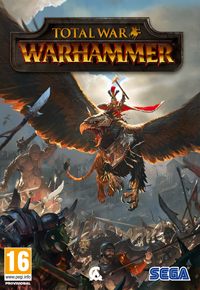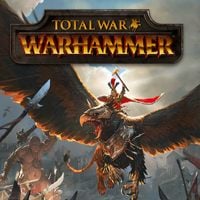Total War: Warhammer review – Old World in new garments
Warhammer + Total War is among the most basic mathematical equations – come to think about it, it’s actually surprising that it took that long for Creative Assembly to finally make this game. Today we know that it was totally worth the wait.
The review is based on the PC version.
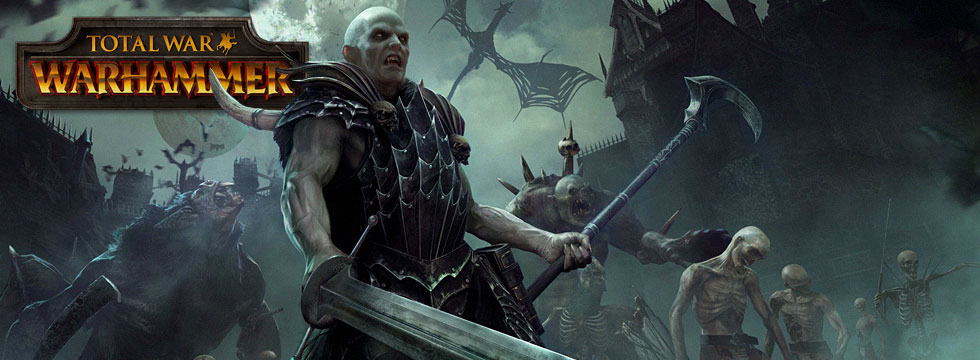
- Total War in the world of Warhammer!
- Four very distinct factions;
- Dark fantasy setting is perfect for this sort of game;
- New additions such as magic, powerful heroes, and flying units;
- The AI can handle battles well (most of the time);
- Simplified province management;
- Rather approachable system requirements and decent optimization;
- Lots of fine details in the UI, music, units, and cutscenes.
- Warhammer should have gotten a new engine;
- Poor publishing practices (cutting out content that later becomes DLC);
- Some simplifications in battles (no formations);
- Sometimes the mechanics are more important than the lore;
Total War: Warhammer is a game that just had to succeed. Blending one of the most popular fantasy universes with the mechanics of a renown strategy series is in fact very natural, as proved by numerous mods that brought subsequent installments of Total War into the Old World. Creative Assembly knew this well enough, and finally decided it was high time for a full scale installment – but while they did introduce many new features, they chose a rather prudent approach, using the tried engine and the mechanics of empire management, which all the fans of the series will be familiar with. This resulted in a very solid game, but one that can leave you with a certain feeling of unfulfillment. Warhammer deserved a revolution – a revolution which is nowhere to be seen. Still, we got one of the best Total Wars ever – not a perfect Total War, but one which is spectacular, features great atmosphere, and provides countless hours of pure fun. In short, it’s awesome.
A world destined to fall
Warhammer is among the oldest and most recognizable dark-fantasy universes. The key ingredient of its grim atmosphere is the looming Armageddon – humans and their allies have managed to postpone the inevitable end a couple of times, but ultimately, they have no other choice but to fall. The forces of Chaos, led by the mighty Archaon, will crush and decimate the Old World once and for all. This game starts not long before those events – the last leader of the empire, Karl Franz, has came to power, and the forces of Chaos are preparing the ultimate invasion. Total War: Warhammer takes place right before the prophesized end of times.
As a fan of Warhammer I was really happy to see that people from Creative Assembly have successfully infused the gloomy mood of that universe into their strategy game – to a large degree, it’s thanks to the high level of difficulty – there’s not a moment when a deadly threat isn’t looming in the background. At the beginning of the campaign we’re dealing with inferior factions and rebels – a dozen turns later, the Chaos’ invasion of Norscan abominations descends upon the Old World. The mood is influenced not only by the cutscenes introducing each of the four campaigns, but also by some less apparent details, such as the esthetics of the strategic map, the music, or design of the units. Even the UI, and the quotes appearing during loadings (although sometimes too obscure) are doing a good job introducing the player to the universe.
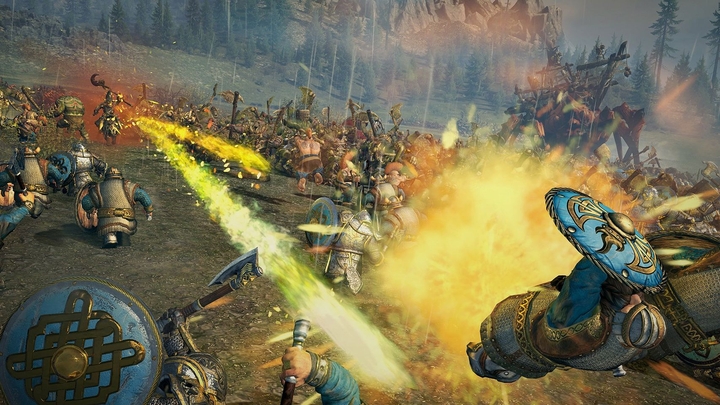
However, on some occasions it was obvious that the game’s mechanics were a priority – and not the setting. For instance, there was a vampire lord, addressing his not-so-brainy army of undead with a motivating speech right before a battle or a possibility to release... captured skeleton soldiers. I really wish the devs had paid more attention to such elements – no worries, they don’t ruin the mood, but they can be really annoying, especially for the fans of the universe.
Old World – old engine
Warhammer is a rightful member of the Total War family. The Creative Assembly studio, which began its adventure with the series sixteen years ago, could not have found a better way to celebrate releasing the 10th game in this franchise than by joining forces with the Warhammer universe. It’s a shame, however, that the devs decided to stick to the old engine. The technology is now seven years old, and that’s pretty noticeable. The graphics aren’t bad, but I was expecting something more spectacular from Warhammer. A minor upside of the Warscape engine is that the game really runs smoothly and doesn’t have monumental system requirements. It’s also decently optimized.
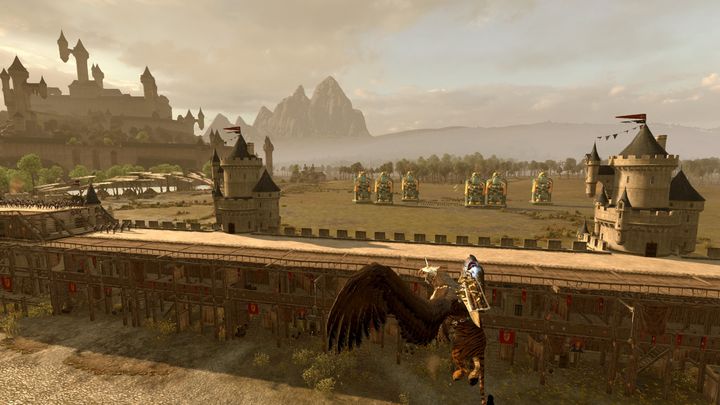
What needs improvements in terms of graphics? Mainly the ground textures and plants, as well as the “attack of clones”, typical for the Total War series. The engine is not only about the graphics, though – using Warscape makes anyone who had played any Total War game instantly feel at home. The cavalry (now riding not only on horseback, but also on spiders and wolves) still crushes formations of infantry in the same way. The artillery and archers are also handled similarly. Creative Assembly decided not to fix something that wasn’t broke, which can hardly be called a bad decision even if we’d still like something more.
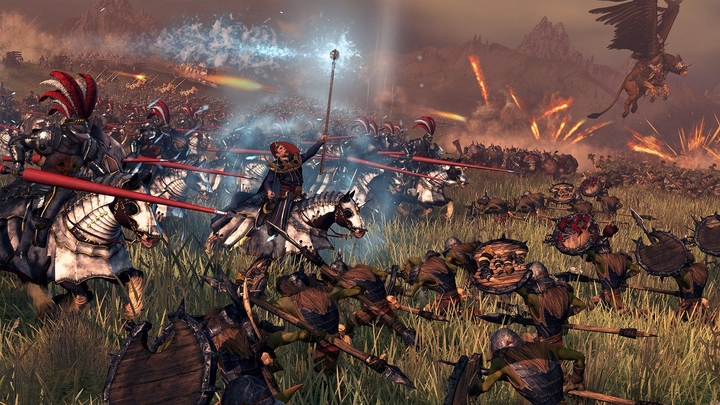
But sticking to the old technology doesn’t mean that this game is just another Total War in a new disguise – there’s plenty of new mechanics. The economy was somewhat simplified – we cannot set the amount of tax to be collected: we can only decide whether we want to collect the tax or not (in order to improve the stability in a region). There are no seasons or squalor in the cities. In the long run, those are some good innovations that allow focusing more on wars and battles – the latter have also undergone some simplifications. We can no longer adjust the distribution of soldiers, which was pretty useful for avoiding artillery fire. What’s more surprising, however, is that the player no longer has the ability to change formations of units. Fortunately, the battles were enriched with powerful special and flying units as well as magic, thus introducing a lot of tactical depth.
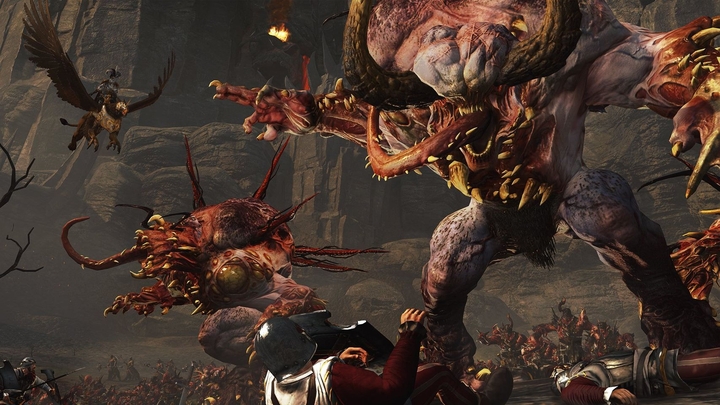
Heroes at war
Until now, the Total War series was about clashing armies – not individuals. Of course, an experienced unit seasoned in battle was much more useful than even a couple of regiments of soldiers who haven’t seen any action yet, but there were never real heroes in these games. This is a major change in Warhammer – each army is now commanded by a lord, who takes an active part in battles; heroes can also be recruited – both deadly warriors and fearsome mages. Each character of this type is worth at least several basic units, and in time, as they gain more experience, they become even more dangerous. This allows situations where an army outnumbered two or three to one, but commanded by a lord, can actually come out on top if their opposition has no leader. As a result, strongholds are much harder do defend without lords or at least heroes. It’s a significant change, and one worth considering at the beginning of the adventure.
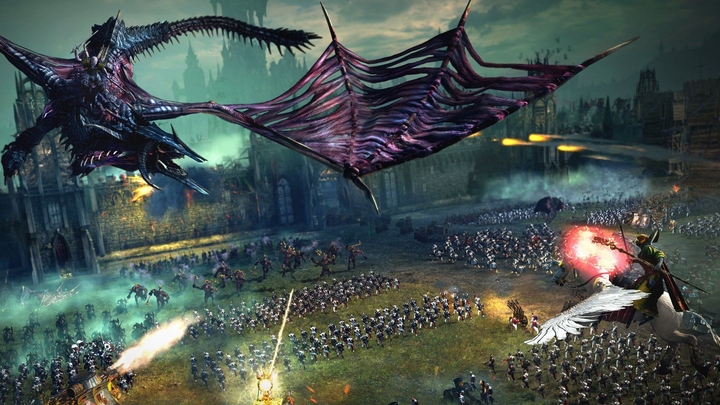
Along with the lords, Warhammer introduces a considerable amount of RPG elements. Each hero can level up – it allows unlocking special abilities or spells that make them even more powerful. The way they move on the battlefield also changes: a vampire lord, Mannfred von Carsteinem, first can only walk, then mount a hellish horse, and finally is able to fly atop a dragon. The heroes also get items that make them, or their soldiers, stronger – all this combined, together with scripted missions concerning individual lords, brings to mind Heroes of Might & Magic. The similarities are superficial yet... noble. In practice, this means that special care has to be taken of the leaders and heroes of our armies – losing them to an assassination or in battle means losing (in the best case for a couple of turns) all their abilities and experience.
The color of magic
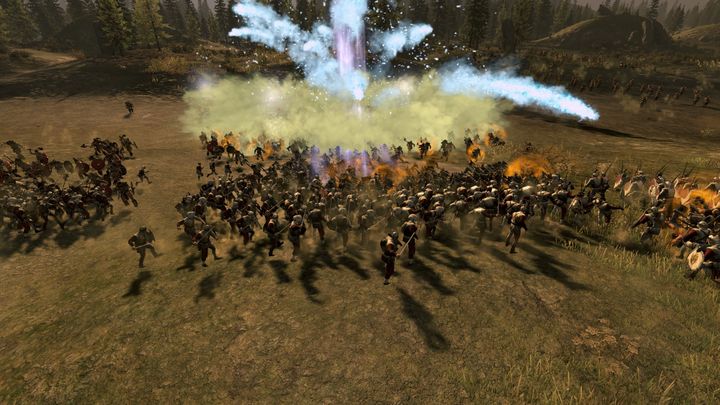
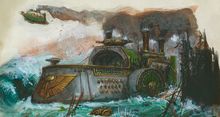
In Total War: Warhammer there are no naval battles. A fleet can be assembled, but the battles are automatically resolved on the strategic map. If one of the purchasable DLCs doesn’t change that, we’ll have to wait until another Total War: Warhammer.
The heroes and the lords are not the only powerful entities on the battlefield. Each faction has different kinds of outstandingly powerful units available: Orcs have enormous spiders and giants; different monsters are available in the ranks of Chaos and the Vampires. In some cases there’s a couple of them in a single unit, but the most powerful ones are fighting alone. Underestimating them because of inferior numbers is a serious mistake – they can easily wipe out a regiment of ordinary troops. During battles, I was trying to prioritize those foes, and it seems reasonable: when the enemy loses their lord or an enormous troll, they become much easier to defeat.
Magic is also extremely important in battles – the most powerful spells can determine their outcome. Relying only on magic, on the other hand, can be very risky – the amount of mana that can be used depends on the winds of magic on the strategic map, and their intensity varies. I’d like to emphasize that spells cast during battles look simply amazing – they are spectacular and very immersive. The flying units are equally important: for the first time in the series, we can just fly over even the most powerful unit of a hostile army and strike a crushing blow to archers staying away from the main force. The abovementioned Mannfred von Carsteinem is excellent in this role when he mounts his enormous dragon.
What’s even more important, all these changes didn’t affect the overall balance of battles. Every faction has its assets and weak sides. Such revamp of the formula served the series well – the scope of changes is comparable to what we’ve seen in Empire: Total War.
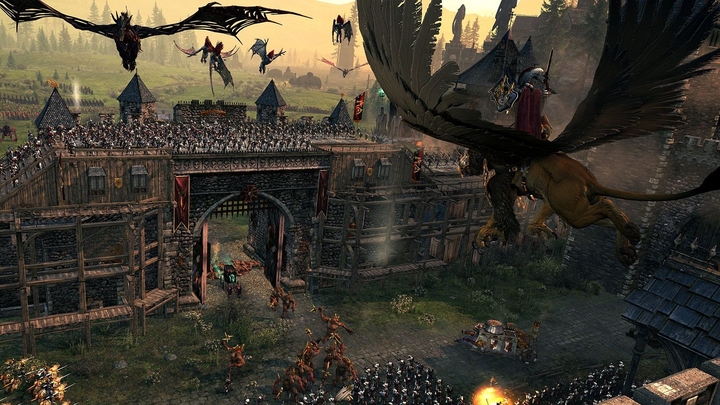
No place for wimps
The difficulty level has always been a problem in the Total War series. In Warhammer it has both its advantages and shortcoming, but I think it was overall good. The AI doesn’t pose a Darks-Souls-level-of-threat, but doesn’t let the players do everything they want, either. It knows how to use cavalry or flying units to its advantage, but at the same time, it can be caught off-guard at certain moments – for example when it lets its units be fired at by artillery for quite a long time before the battle really begins.
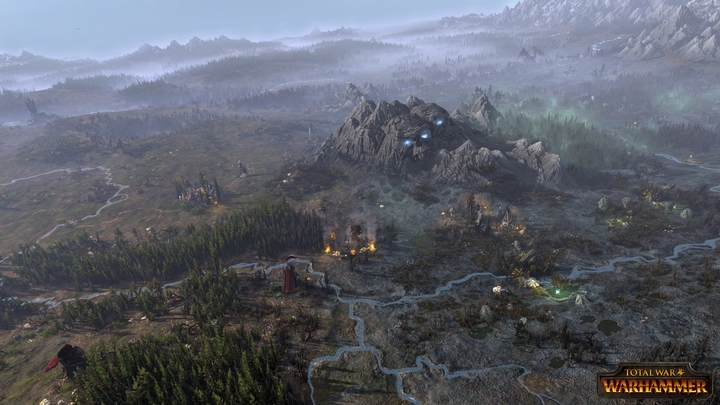
Things are a bit different on the strategic map – the game gets more difficult there, maybe even too difficult, although I’ve got to admit that the feeling of constant danger works well in the Warhammer universe. The enemies attack those places that are poorly defended, and are generally good at choosing weak spots. The armies of Chaos, which descend upon the world around 70th turn, are numerous and powerful – during my first approach to the campaign, the ruthless forces under the command of Archaon slaughtered my troops without mercy. Still, you can choose the easy difficulty setting, making the game a lot more approachable – the towns generate more income, and the population isn’t as quick to rebel; even those two elements alone can make a world of difference in terms of difficulty. On easy, I managed to finish the campaign faster – in 130 turns – playing as the Dwarves.
Where the Dwarf and Goblin play
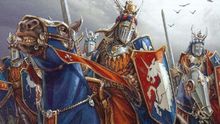
Is Bretonnia coming as a playable faction?
There are four factions in Total War: Warhammer, with the Chaos being the fifth. Only players who pre-order the game or buy it within a week from the release will be able to command it though (the latter possibility is the result of the outrage that spread throughout the community). Most probably, the sixth faction (coming with the first free DLC) will be Bretonnia, based on Medieval France – some of its units are already available in skirmish and multiplayer modes. We will probably be able to purchase more factions, along with many different elements of the game. Such a policy, which basically boils down to cutting stuff from the base version of the game and then selling those elements individually has never been a fan-favorite, and has to be strongly condemned. As for now, the game offers four campaigns, each focusing on a different faction, and hence on a different race.
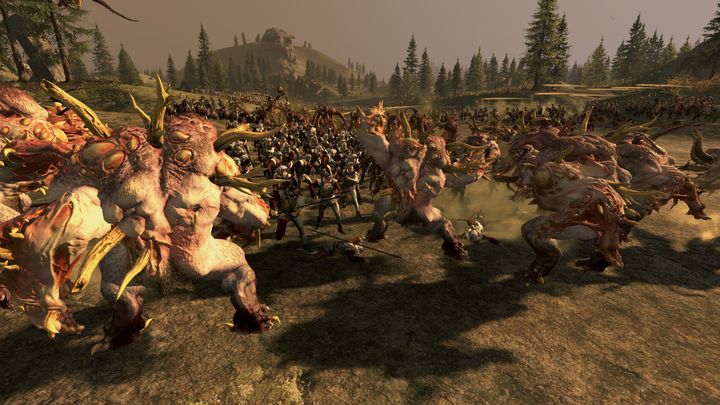

How many times can you finish one campaign? The nature of the Warhammer universe seems to be saying: “not so many”. I approached the Dwarf campaign two times – once successfully – and in both playthroughs things played out similarly – I took care of the Orcs in the North, then I challenged the Greenskins in the South, and then started uniting the rest of Dwarven lands. This doesn’t change the fact that Total War: Warhammer offers distinctive factions and dozens of hours of gameplay, and that’s something.
The army of Karaz-a-Karak-based Dwarves relies mostly on slow, heavily armored infantry – they are unmatched in close combat, but when one tries to chase down the remains of a hostile army after a victory, they can run into some trouble... until they build Gyrocopters. What’s more, the Dwarves, apart from regular quests, have the so-called “Book of Grudges” – not tackling those grudges will increase unrest in the state. During the campaign, the goal of the Dwarves is to unite (either directly or by alliances) all Dwarven strongholds, as well as to destroy the faction of their sworn enemies – the Greenskins. The Orcs and Goblins are in turn distinguished by the so-called Fightiness – this feature describes their engagement in war. Should there be no war to fight in, the savage soldiers will start looking for opponents among each other. On the other hand, if we max this coefficient, our troops will get the support of one additional army controlled by the AI which is both in line with the lore, and somewhat evens out our chances, since Orcs and Greenskins don’t have access to such powerful units as their main opponent, the Dwarves.
The Vampires – the Empire’s prime enemy – don’t have a typical taxation system. Instead, the undead collect points of dark magic. There are no archers among them either, but they make up for it with strong flying units and the ability to resurrect fallen troops during battles. The administration of their dark world is also a slightly different story – the order is maintained by means of the Vampiric corruption, which spreads throughout their lands like the plague in Medieval Europe. The Empire, led by Emperor Karl Franz – one of the most recognizable characters of the universe – is the most classic faction. The first task of the new liege is to quell secession and discipline disobedient vassals. The empire has the most versatile army in the game, as well as a network of public offices, bearing a resemblance to solutions known from previous installments.
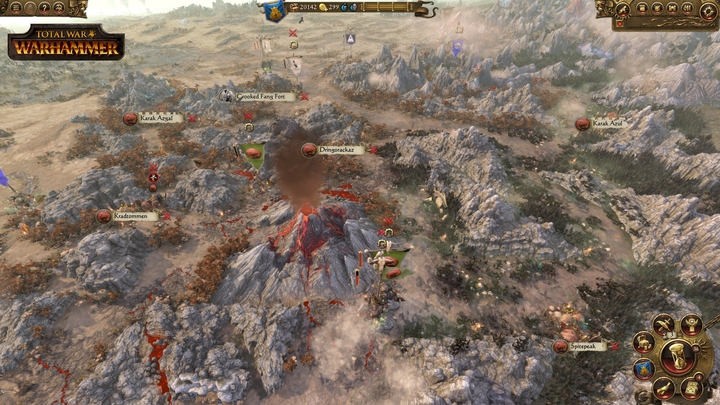
The bottom line is that all the races of Total War: Warhammer indeed vary a lot in terms of military, administration, and heroes’ abilities. Some of the differences turn out to be only superficial, as for example the Vampire’s Dark Magic, which works exactly like a regular currency, but the basic mechanics are different for each of the four races. I think this provides a nice balance for the disadvantage of a small number of playable factions.
A couple of flies in the ointment
The most unpleasant part of any review is the moment when you have to expose the flaws. In case of Warhammer, they mostly boil down to different kinds of shortcomings. There’s nothing that would disqualify this game – Warhammer’s flaws are like a small rock in your shoe; they won’t kill you, just annoy you a little. The prioritization of mechanics over the lore that I’ve mentioned earlier on can sometimes make you think that this is just a mod you’re playing: the Dwarves, whomever they fight, often yell “Death to Orcs!” – one has to admire their devotion if they still think about killing Orcs when clashing with an Imperial army. The “Book of Grudges” can also be pretty irritating – let’s say you get a mission to kill a specific hostile general. Easy? Not if he doesn’t feel like fighting and has to be chased all over the map like in a Charlie Chaplin movie. Sometimes it’s even worse – you can be tasked with destroying a hostile army which is separated from you with a couple of neutral territories.
The AI goes south sometimes as well. On the strategic map level, I often encountered a situation when a given faction declared war on me despite the fact that we were separated by a tract of neutral territory, so there was no way that any fighting could ever occur. On top of that, the AI would sometimes submit a peace treaty a couple of turns later, offering a lot of money in exchange. It sometimes had problems in assessing the outcome of a battle, as well: it’s hard to call it a “decisive defeat” if I was the only one who inflicted any damage (and pretty massive at that).
The army leaders’ story quests are also pretty dull. They were strongly promoted before the game’s release, however, they all come down to waging a battle; if the player wins, they receive special items. The problem is that we get so many banners and weapons during the game that even the unique items that we sometimes obtain are nothing particularly thrilling. Total War: Warhammer isn’t flawless – apart from the (typical for the series) practice of cutting up content and then selling it as DLC, the game suffers from various minor issues.
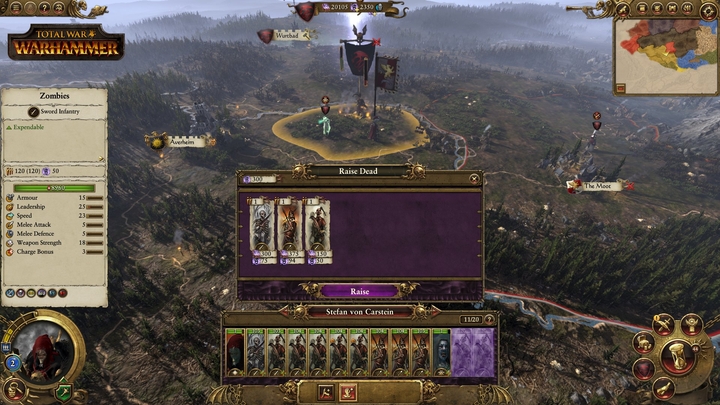
A precise blow of a warhammer
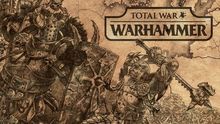
According to the developers’ plans, Total War: Warhammer is the first of the three games planned for release within this universe. This becomes clear if we look at the absence of important races such as Elves or Skaven – they’re likely to appear in the next game. I’m worried about something else, though; if this trilogy is supposed to constitute one big game, won’t the engine be conspicuously outdated after a couple of years?
After playing Total War: Warhammer for over 70 hours I can honestly say that it’s one of the best strategies of this year, and we’ve got a pretty good year going. Seems that the blend of dark fantasy and Total War’s mechanics just couldn’t have gone wrong. Creative Assembly have put years of experience into good use; the solutions which proved their value in older installments are still here – the mechanics of province management and development, the leader development system, or the imperial public offices. At the same time, there’s a good dose of novelties – mainly in terms of faction variety, but also on the battlefields – and that’s arguably the most important part of the Total War series. It’s a shame, though, that the devs went only half way with the changes, and didn’t provide as with a revolutionary production powered by a brand new engine. Still, it’s hard to blame them for making “merely” an amazing game.
Total War: Warhammer is a product that will become even better over time. In the coming months, the title will receive a ton of expansions, additional factions, and other minor tweaks. Enriched with those expansions and fan-made mods, Warhammer can become pretty epic. If the devs manage to iron out all those flaws I mentioned, the score can easily be increased by one point. Warhammer will come close to perfection then.
Total War: Warhammer
Total War: Warhammer review – Old World in new garments
Warhammer + Total War is among the most basic mathematical equations – come to think about it, it’s actually surprising that it took that long for Creative Assembly to finally make this game. Today we know that it was totally worth the wait.
